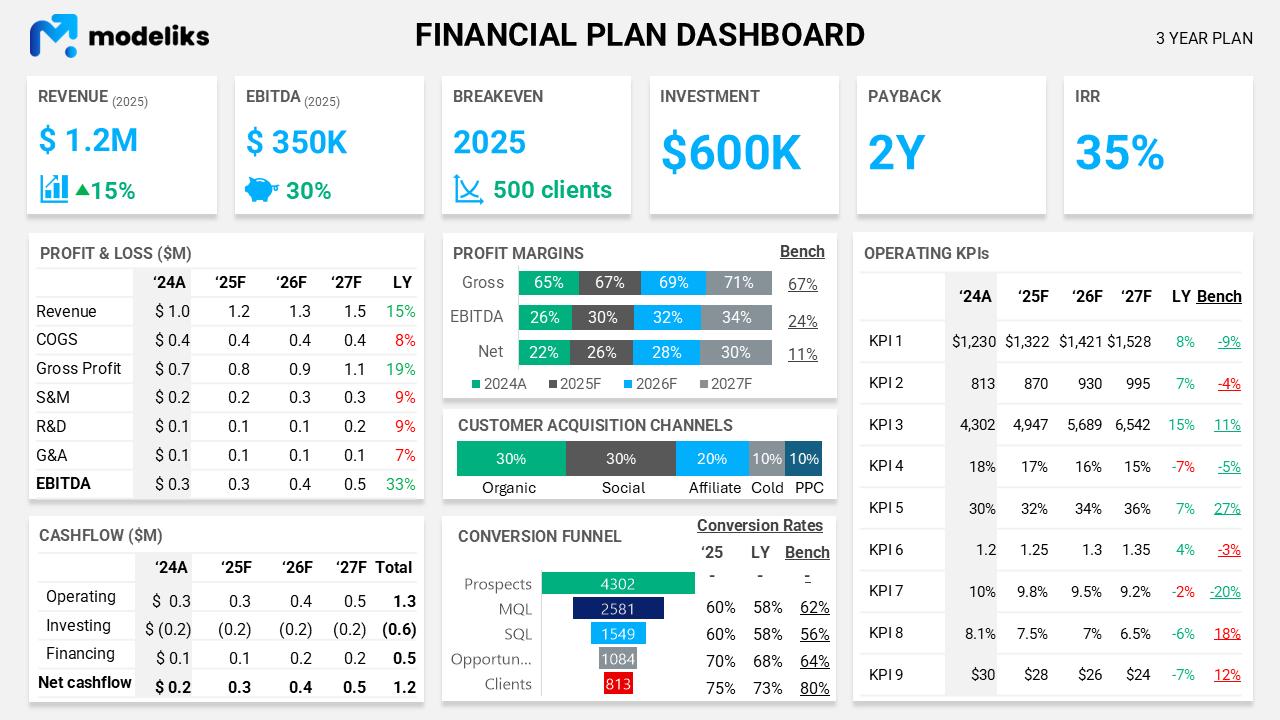Our Sheet Metal Fabrication Financial Model Structure covers all the essential aspects you need to consider when starting or scaling a Sheet Metal Fabrication business. By following this structure, you can better understand your revenue streams, costs, and assets, helping you optimize profitability and strategically plan for growth.
Financial planning is a crucial step for any business owner—especially in sectors as capital-intensive as sheet metal fabrication. Successfully navigating the complexities of this industry requires a well-structured financial model that considers various financial factors vital to the growth and sustainability of the business. This model should outline typical revenues, direct costs, employee responsibilities, operating expenses, and assets needed in a sheet metal fabrication business. It might also spark ideas for new and profitable revenue streams; however, many overlook the importance of a comprehensive approach. The Sheet Metal Fabrication financial model structure, although complex, serves as the foundation for informed decision-making—because it encapsulates essential elements for success, making it indispensable.
The Sheet Metal Fabrication financial model structure
Revenues
A sheet metal fabrication business often generates revenue through several streams; however, the calculations can be intricate. For instance, custom fabrication projects yield revenue by multiplying the volume of projects with the average price per project. Product sales, on the other hand, equate to the number of units sold multiplied by the price per unit. Maintenance and repair services require computation: this involves the number of service calls times the average charge per service. Consulting services are determined by hours billed, multiplied by the hourly service rate. Prototyping services generate revenue based on the number of prototypes created, which is at their average price point. Leasing of equipment can be calculated based on rental contracts multiplied by the monthly leasing charge, which is significant. Training, however, derives from the number of participants times the training fee per person, because this aspect is vital for revenue growth. A well-structured Sheet Metal Fabrication financial model is needed to manage these revenue streams.
Cost of goods sold
- Material Costs: Metals, plastics, and other materials needed for production.
- Labor Costs: Wages of individuals directly involved in producing goods.
- Utilities: Energy costs attributed directly to production activities, which can fluctuate.
- Machinery Maintenance: Regular upkeep expenses for production equipment.
- Subcontracting Costs: Payments to third-party fabricators or suppliers.
Material costs, including metals and plastics, are essential for production. Labor costs, the wages of individuals directly involved in producing goods, can fluctuate significantly; however, they remain a crucial aspect. Utilities, which encompass energy costs attributed directly to production activities, can increase unexpectedly. Machinery maintenance, a necessary aspect of production, incurs regular upkeep expenses. Subcontracting costs arise from payments to third-party fabricators or suppliers, but these can vary based on demand. Although all these elements contribute to financial planning, this complexity makes budgeting challenging.
Employees
- Production Manager: Overseeing daily operations and ensuring production targets are met; however, challenges often arise.
- Quality Assurance Specialist: Ensuring products meet company and regulatory standards is crucial because failure can result in significant repercussions.
- Design Engineer: Developing detailed designs and plans for new fabrications requires creativity but also strict adherence to specifications.
- Sales Manager: Driving sales growth and maintaining relationships with clients is essential for success, although it can be demanding work.
- Machine Operators: Operating fabrication machines and ensuring they function smoothly is fundamental; however, the risk of malfunctioning exists.
Operating expenses
- Rent: Lease agreements for manufacturing space; this is a crucial expense.
- Utilities: General utilities not directly tied to production can vary significantly; however, they are essential for operations.
- Insurance: Protects the business from various potential liabilities, although it can be costly.
- Marketing: Promotion and advertising activities are vital for growth; this generates awareness.
- Office Supplies: Everyday consumables for office use are often overlooked, but they are necessary for efficiency.
- Transportation: Delivery and logistics expenses can add up quickly, especially during peak seasons.
- Software Licenses: CAD licenses and other essential software are important because they enable productivity.
- Professional Fees: Payments for legal and financial advisory services are often underestimated, yet they play a critical role in business strategy.
- Training: Staff development programs.
- Cleaning and Maintenance: Upkeep of the workspace is crucial; however, it often gets overlooked. This neglect can lead to various issues, decreased productivity, and an uninviting environment. Although some may argue that cleaning is a minor aspect of operations, it significantly impacts overall efficiency. Regular attention to maintenance is essential. Many people fail to recognize the importance of these tasks.
Assets
- Machinery and Equipment: Essential for the manufacturing process.
- Factory or Workshop: Represents the physical space for production.
- Delivery Vehicles: Required for transportation and delivery of goods play a crucial role in logistics.
- Computer Systems: Facilitate design and administrative operations; this is vital for efficiency.
- Office Furniture: Necessary for the office environment, although it often goes unnoticed.
Funding options
- Bank Loans: Traditional loans from financial institutions serve as a cornerstone for many businesses.
- Angel Investors: Individuals seeking investment opportunities in small businesses play a crucial role in providing capital.
- Venture Capital: Funding offered by firms to startups with potential for growth is vital.
- Equipment Financing: Specialized loans for equipment purchases can alleviate financial pressure.
- Grants: Non-repayable funds from government or private organizations present another avenue; because they do not require repayment, this can be particularly advantageous.
Driver-based financial model for Sheet Metal Fabrication
A robust Sheet Metal Fabrication financial model for a sheet metal fabrication business is centered around key operating KPIs (drivers) relevant to this industry. These drivers are the backbone of the business strategy and guide resource allocation.
- Production Rate , the speed at which products are manufactured, is essential;
- Machine Utilization , measures how effectively machinery is used, is equally important.
- Material Utilization Rate reflects the effectiveness of material use in production.
- Order Lead Time , the duration to fulfill an order from inception to completion, influences customer satisfaction.
- Sales Conversion Rate , the percentage of inquiries that convert to sales, indicates market effectiveness.
- Customer Retention Rate shows the ability to maintain repeat customers.
- Workforce Productivity , output level per worker, directly impacts overall efficiency.
- Downtime Ratio: Proportion of time machinery is not operational.
- Return Defect Rate: Percentage of products returned due to defects.
- Cash Flow Breakeven Point: Point at which expenses are covered by revenues.
Driver-based financial planning is the method of pinpointing key activities (drivers) that most significantly affect business outcomes. By building financial plans on these activities, businesses establish clear links between financial results and resources needed to achieve them, like employees, marketing budgets, and equipment. If you want to know more about driver-based financial planning and why it is the right way to plan, see the founder of Modeliks explaining it in the video below.
Need a business plan?
Create one with Modeliks AI in the next hour!
AI powered business planning for Startups and SMEs.
The financial plan output
The objective of financial forecast outputs is to enable business proprietors, management, board members, or investors to quickly grasp how their sheet metal fabrication enterprise will perform in the future. They seek reassurance that the plan is well thought out, realistic, and achievable. Additionally, it is essential to comprehend what investment will be required to realize this plan, as well as the anticipated return on that investment. To achieve these aims, there exists a concise template on how to effectively present your financial plan.

Apart from this one-page summary of your plan, you will need these three projected financial statements: Profit and Loss, Balance Sheet, and Cash Flow Statement, however, those are pivotal for your success.
Sheet Metal Fabrication financial model summary
A professional sheet metal fabrication financial model will help you strategize your business operations. It can assist in identifying resources needed to achieve targets, set performance benchmarks, secure funding, and make informed decisions to grow and manage your business successfully. However, this model is not without its challenges; you must be diligent in understanding all components. Although it provides clarity, you might encounter unexpected complexities. Because of this, careful consideration is essential in crafting and managing a functional Sheet Metal Fabrication financial model.
If you need help with your financial plan, try Modeliks , a financial planning solution for SMEs and startups or contact us at contact@modeliks.com and we can help.
Author:
Blagoja Hamamdjiev
, Founder and CEO of
Modeliks
, Entrepreneur, and business planning expert.
In the last 20 years, he helped everything from startups to multi-billion-dollar conglomerates plan, manage, fundraise, and grow.

TAKE MODELIKS FOR A SPIN
Not sure which plan?
Start with a 15 days free trial.
You will have access to the full functionality of Modeliks. The only restriction in the free trial is that you cannot download or share your business plan outside Modeliks. Credit card is not required to subscribe for the free trial.






